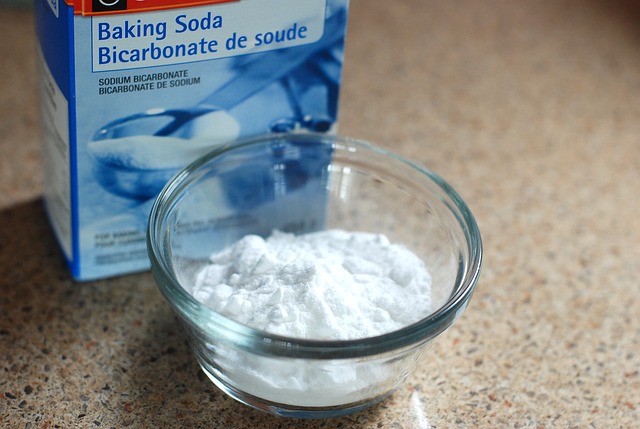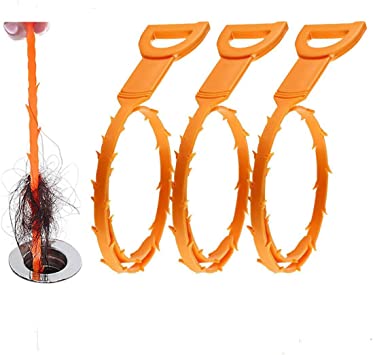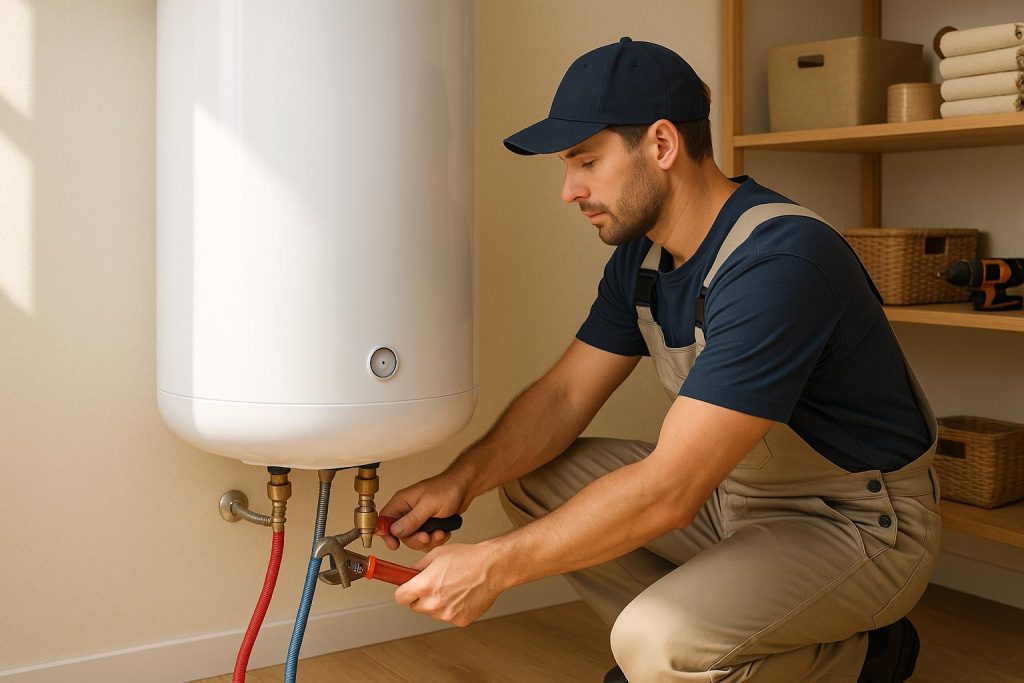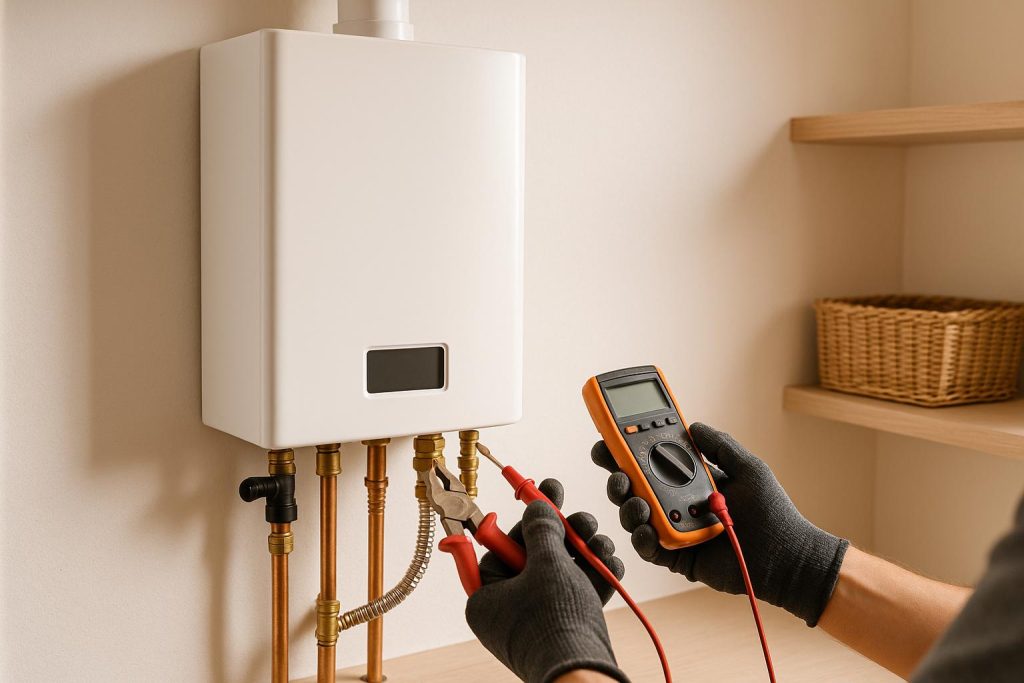
Unclogging drains with baking soda and vinegar is a natural and environmentally friendly method. Here’s a brief summary of the steps:
- Gather Supplies: You’ll need baking soda, vinegar, a pot of boiling water, and a drain stopper or rag.
- Remove Excess Water: If there’s standing water in the sink or drain, remove as much as possible using a cup or bucket.
- Pour Baking Soda: Start by pouring about 1/2 cup of baking soda down the clogged drain.
- Add Vinegar: Pour about 1 cup of white vinegar into the drain on top of the baking soda. You’ll hear fizzing and bubbling as the two substances react. This chemical reaction helps break down grease, soap scum, and debris causing the clog.
- Cover and Wait: Cover the drain with a drain stopper, rag, or any suitable seal to keep the fizzing action contained within the drain. Allow the mixture to sit for about 15-30 minutes. During this time, the solution works to break down the clog.
- Boil Water: While you wait, boil a pot of water. The water should be brought to a rolling boil.
- Flush with Boiling Water: Carefully remove the drain cover or seal, and slowly pour the boiling water down the drain. The hot water helps flush away the loosened clog and residue.
- Repeat if Necessary: If the clog doesn’t clear with the first attempt, you can repeat the process a few times to further break down and dislodge the blockage.
- Test Drain: Turn on the faucet to see if the water drains smoothly. If it does, the clog is likely cleared.
- Prevent Future Clogs: To prevent future clogs, consider using drain strainers to catch debris and avoid disposing of grease or large food scraps down the drain.
Why Drains Clog
Most of the time, drain clogs when something which should not be thrown down the drain ends up being thrown. No matter how much you are careful, at one point or another you will have deal with a clogged drain.
If you look underneath your kitchen or bathroom sink, you will see that a piece of the drainpipe is bent into a U-shape. That is usually by design rather than accident.

The U-shaped bend in the drainpipe is called a drain trap or a P-trap. Every fixture in your house has a P-trap although you cannot see the one in your shower/bathtub drain.
Just like its name suggests, a P-trap traps potential drain clogs preventing them from clogging the drainpipe farther from the fixture, where unclogging would be more difficult. You must admit that removing a clog in the P-trap is easier than removing one that is 10 feet from the fixture.
Apart from that, the drain trap holds a little amount of water at all times which acts as a barrier preventing sewer gases from coming up through the drain. If the P-trap is leaking or if you have travelled for a while, the water will evaporate and the P-trap will be empty. A sewage smell will be felt in the house.
If something that is too big to flow down the drainpipe is flushed/washed down the drain, it will be held in the P-trap. A partial clog will cause a slow draining drain.
A slow draining fixture that is not fixed will develop to a fully clogged one and it will not be draining out water. If you have standing water in a bathtub or sink then the drain is fully clogged.
How to Unclog a Drain with Baking Soda and Vinegar
Baking soda and vinegar will only unclog one drain at a time. If all the fixtures in your house are clogged or draining slowly, you need something stronger than baking soda and vinegar. In that case you could be dealing with a clogged main house drainpipe or even a clogged vent stack.
If on the other it is just one fixture that is clogged, baking soda and vinegar will unclog it successfully most of the time. Here is how to unclog a drain using baking soda and vinegar:
1. Run Hot Water Down the Drain

If you have a slow draining fixture, give the water sufficient time to drain. Remember that the water in the trap is still cold and we need to replace it with hot water (boiling water unless you have a ceramic fixture).
Dump a gallon of hot water down the drain and give it time to loosen the clog. Unlike cold water, hot water is very effective in dissolving soap scum, grease, hair and any other gunk that you can find in a drain trap.
If you have standing water in your drain, it makes no sense pouring more water in the fixture. In that case, what you should do is manually drain the fixture.
You want the baking soda and vinegar solution to work directly on the clog but not be diluted by the standing water in the fixture. Grab a cup and bucket and scoop out as much water as you can and soak up the remaining one with a sponge. Don’t forget to have your groves on.
2. Pour Baking Soda and Vinegar

Baking soda, which is an alkaline/basic product is scientifically known as a sodium bicarbonate. It is a weaker base than borax (which is banned for use in Europe but legal in United States).
Vinegar on the other hand is weak acid, composed of acetic acid and water. When baking soda and vinegar are mixed, a fizzing reaction occurs, producing carbon dioxide gas and water.
It is the bubbling reaction between these 2 products that breaks down the clog into smaller pieces that are easy to flow down the drainpipe.
Pour 1 cup of baking soda down the drain followed slowly by another cup of vinegar. Don’t dump the vinegar all at once since the reaction happens too fast and can splash in your face.
Wait for 10 to 15 minutes for the solution to work out its magic. While you wait, start boiling about a gallon of water on the stove.
While unclogging a slow draining toilet or a toilet with standing water, it is a best idea to drain the water at the bottom of the toilet bowl. This gives the solution the chance to act directly on the clog thereby increasing its effectiveness.
3. Blast Hot Water Down the Drain

After about 15 to 30 minutes of pouring the baking soda and vinegar in the drain, dump a gallon of boiling water down the drain. Although baking soda and vinegar will have done most of the work, the water breaks down the clog further, and flushes it down the drain.
Please not that if you are unclogging a drain with a ceramic fixture like a bathroom sink or toilet, don’t use boiling water as it can crack it. Just hot water will do it. If your sink has a hot water faucet, open it full blast for about 30 seconds.
Depending on the severity of your clog, sometimes you may need to repeat the process to completely unclog your drain.
Unclogging a Kitchen Sink with a Garbage Disposal
If you have a double-bowl kitchen sink with one of the bowls connected to a garbage disposal, you need to make sure that you unclog the sink bowl that the garbage disposal is connected to. The good thing is that both the sinks share the same P-trap.
Here is how to do it:
- Run hot water for 30 seconds to 1 minute to loosen the clog a little.
- Pour 1 cup of baking soda down the drain and run the garbage disposal for a few seconds.
- Add a cup of vinegar and wait for 10 minutes for the solution to work. While some of the solution will remain in the garbage disposal, most of it will flow out to the P-trap to break down the gunk clogging it as well.
- After the 10 minutes, turn on the hot water and run the garbage disposal for another few seconds.
- Fill the garbage disposal with ice cubes and add half a cup of salt. Run it until all the ice has melted. The ice and salt will scrape the garbage and flush out all food particles.
- To leave your garbage disposal smelling fresh, turn on the cold water and start running the unit as well. Cut a lemon into small slices and drop one piece at time inside the garbage disposal.
For more information on how to unclog a garbage disposal check out this post.
Good Alternatives
If baking soda and vinegar solution doesn’t work, there are still other methods you can try.
Bathroom and Kitchen Sinks
If your kitchen or bathroom sink is badly clogged and the baking soda and vinegar solution will just not move the clog, the easiest and fastest solution is to remove the clog physically.
Duck under the sink and remove all the stuff that you store there. What you want to do is disconnect the P-trap and clean it then install it back afterwards.
Before disconnecting the P-trap place a small bucket or pan under it to collect any water that is still left there. If you have a plastic drainpipe, you will not need any tools disconnecting it.

The connections are usually hand tight and all you need to do is disconnect the P-trap from the tailpiece (vertical pipe from the drain opening) and drain elbow. If you have a metallic drainpipe, you will need either a wrench or slip-joint pliers.
Once the P-trap is out clean it out thoroughly, and before connecting it back make sure that the garbage disposal drain hose is not clogged (if you have a garbage disposal). If it is clogged, disconnect it from the garbage disposal and clean it as well.
Bathtub/Shower Drain
With a shower drain, the number one cause of clogs is hair. In order to access the drain and work on it properly, you will need to remove the drain cover.
If there are screws, remove them and if there are none just pop it out using a flathead screwdriver or grab it with a needle-nose pliers and pull it out.
To remove the hair, you can opt to buy a drain hair removal tool from the nearest home improvement store. This tool can also be used to pull hair out of a bathtub or bathroom sink drain.

You can also grab a wire coat hanger, straighten it and make a hook on one of its ends using a pair of pliers. Use the wire to pull out hair from the drain. Once most of the hair has been removed blast hot water down the drain to clear it completely.
To prevent your shower drain from clogging, consider installing a shower drain hair catcher. A drain hair catcher can be installed in a bathtub drain or walk-in shower drain.
Lastly
If all the above fails, you can try using a drain snake before calling a professional plumber. One thing to know with drain snakes is that they can punch a hole in a drainpipe quite easily, if you have a plastic drainpipe
If you are snaking through a drain and you encounter resistance, pull the cable up a little and then try pushing it once more. Never force the snake cable through a drain.





